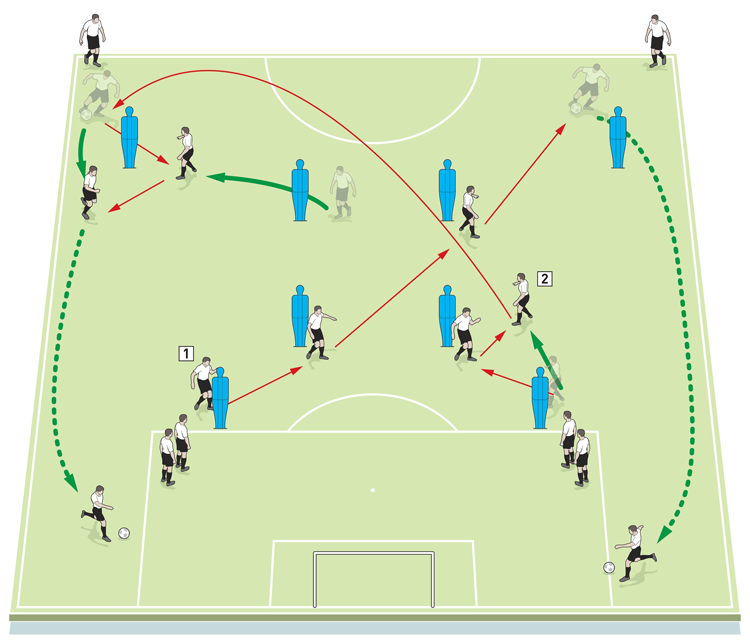The session is about passing the ball quickly and effectively across the width of the pitch to utilise space and to penetrate the opposition. Ultimately, players love passing the ball, so following that logic through, quick and effective link-up play is the best way to create opportunities, find weaknesses in your opponents and score goals.

| Area | Half-pitch |
| Equipment | Balls, cones, goals |
| No. of Players | Up to full squad |
| Session Time | 10mins plus 20mins progressions |
The session is about passing the ball quickly and effectively across the width of the pitch to utilise space and to penetrate the opposition.
Ultimately, players love passing the ball, so following that logic through, quick and effective link-up play is the best way to create opportunities, find weaknesses in your opponents and score goals.
Players need to be comfortable in possession, have a good passing range and be prepared to make unselfish runs, and switching play should always result in a cross or shot, with players quickly building an understanding of why we move play from side to side and to what advantage.
Generally we will practise this session at least once a week.
Sometimes the practice is against mannequins and occasionally against opponents who will be set up tactically as our next opponents. What’s important though is variety – both in terms of technique, and in the involvement of full-backs, centre-backs, wide players and central midfielders, because all of these have a key role in switching play in the practice and, indeed, in match situations.
What do I get the players to do?
As shown, we set up an initial passing exercise with some players conditioned to make short passes through the mannequins while others are looking to feed longer passes over the mannequins.
Switching play
In a simple attack versus defence form we begin by telling players to move the ball across the back four with quick passing, switching play through the midfield with quick penetrating play.
We progress this on to moving the ball across the back four, building up to long diagonal passes from left to right (or right to left) (1).
1

2. Play from right to left: longer passes over the midfield to reach the winger
Full-backs, centre-backs and central midfielders are key passers, with wide players and strikers vital in making themselves free to receive the pass. Having switched play we always try to end up with a cross or shot on target (2).
2

2. Short, quick passing through the midfield
3. Depending on the angle of the final pass the winger can choose to work through the channel or take the ball down the wing for a cross
4. The striker makes a run ‘in behind’ to receive a pass through the channel
5. Midfielder makes a supporting run
6. The opposite winger makes a run for the far post
What are the key things to look out for?
Technically the players’ touch, movement, awareness, understanding, passing range and accuracy are vitally important.
Tactically the players must retain a solid shape with good distances and an understanding of where and when to make certain moves to either receive the ball or create space for other players.
A big part of this is players being comfortable receiving the ball on the half-turn. If they have their backs to play it means they are limiting their options because there’s no vision of what’s around them. You will also see players trying the long ‘wonder pass’ but this should be discouraged in favour of firm, controlled, positive passing.
Editor's Picks
Attacking transitions
Deep runs in the final third
Using the goalkeeper in build-up play
Intensive boxes drill with goals
Penetrating the final third
Creating and finishing
My philosophy
Pressing initiation
Compact team movement
Coaches' Testimonials

Alan Pardew

Arsène Wenger

Brendan Rodgers

Carlos Carvalhal

José Mourinho

Jürgen Klopp

Pep Guardiola

Roy Hodgson

Sir Alex Ferguson

Steven Gerrard
Coaches' Testimonials

Gerald Kearney, Downtown Las Vegas Soccer Club

Paul Butler, Florida, USA

Rick Shields, Springboro, USA

Tony Green, Pierrefonds Titans, Quebec, Canada
Join the world's leading coaches and managers and discover for yourself one of the best kept secrets in coaching. No other training tool on the planet is written or read by the calibre of names you’ll find in Elite Soccer.
In a recent survey 92% of subscribers said Elite Soccer makes them more confident, 89% said it makes them a more effective coach and 91% said it makes them more inspired.
Get Monthly Inspiration
All the latest techniques and approaches
Since 2010 Elite Soccer has given subscribers exclusive insight into the training ground practices of the world’s best coaches. Published in partnership with the League Managers Association we have unparalleled access to the leading lights in the English leagues, as well as a host of international managers.
Elite Soccer exclusively features sessions written by the coaches themselves. There are no observed sessions and no sessions “in the style of”, just first-hand advice delivered direct to you from the coach.









